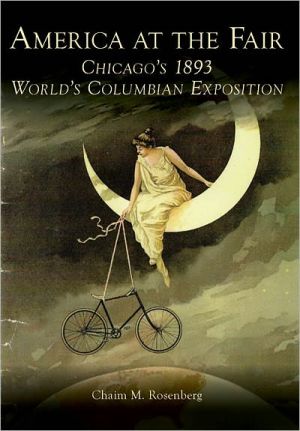

 |

|

The average rating for America at the Fair: Chicago's 1893 World's Columbian Exposition based on 2 reviews is 3.5 stars.
Review # 1 was written on 2010-04-01 00:00:00 William Raine William RaineThere are many books about the epochal Columbian Exposition, the cultural, commercial, and technological watershed whose wonders awed the 28 million visitors who ambled through "The White City" between May and October of 1893. But one book arguably contains more detail than most others: Chaim M. Rosenberg's "America at the Fair." For instance, I already knew that the Columbian Exposition was the first world's "electric" fair and that evening ticket-holders were thrilled by dazzling displays of electric lights. But until reading "America at the Fair," I didn't realize that Edison's General Electric Company and the Westinghouse Electric Company had been involved in a "War of the Currents" since 1883 and that Westinghouse gained not only the right to light up the Chicago fair but that it also won the "best site" award in the Electricity Building. Most books which discuss the Fair's Women's Pavilion also mention that architect Sophie Hayden was commissioned to design the building. But, to my knowledge, none but Rosenberg's relates that because of discouragements suffered relative to her association with the Fair (including being paid significantly less than her male counterparts) Ms. Hayden suffered a breakdown and never designed another building. Perhaps, some readers will find that Rosenberg provides too much detail at times. For instance, some might not care that the New York Life Insurance Company, one of the many insurers of the Fair in case of fire, had assets of 137 million and 224,000 policies. While it cannot be denied that Rosenberg obviously adores numbers and facts, he generally makes those things work for him -- his detailed-filled descriptions can be very illuminating, as seen in the following description of Chicago's 1892 thoroughfares, found in one of Rosenberg's pre-Fair chapters, "From Village to Metropolis": "Town planners made sure that Chicago had its grand boulevards. Michigan Avenue and Oakwood Boulevard were each 100 feet wide. Drexel, Garfield and Western Boulevards were 200 feet wide, while Douglas, Central and Humboldt Boulevards were each 250 feet in width. State Street was Chicago's main shopping street, built to resemble Regent Street in London. Madison Street was Chicago's great east to west thoroughfare. The manufacturing district was located south of Lake Street and east of Halsted Street. Immigrants, factories, and stockyards filled this area of the city." But the book's main thrust, obviously, is the Fair itself and Rosenberg devotes one chapter to each of the following Fair buildings: manufacturers and liberal arts, electricity, agriculture, transportation, machinery, one chapter combining the "freestanding pavilions," and one which lists the nations who took part in the Fair and a detailed description of their displays. He also combines the World Congress of Ideas and the Midway Plaisance into one chapter entitled "Lofty Thoughts and Low Down Fun." Scattered generously throughout the book are black and white photographs, sketches, and advertisements which portray different aspects of the Fair, and, at the center of the book is an absolute treasure: 31 pages of facsimile lithograph trading cards in full color --advertising everything from kerosene lanterns and kitchen utensils to corsets and chocolate -- which were distributed during the Fair as advertisements. Very occasionally, one wishes that the book's plethora of facts were better organized. For instance, when mentioning how Britain came to be one of the "exhibiting nations," Rosenberg relates that it was Robert Todd Lincoln, US ambassador to Britain and son of the late President, who formally invited Britain to the Fair, via Britain's Prime Minister. Rosenberg then goes on to describe, in a short paragraph, the ambassador's lineage and what became of him. It is highly interesting but more than slightly diverting and would have been better placed in a sidebar rather than in the text. But detail-lovers, especially those hungry for information about an event at once as epochal and far removed from the present as the Columbian Exposition, will be thankful for the details, photographic and otherwise, found in "America at the Fair." (Published also at BookPleasures.com) |
Review # 2 was written on 2018-02-27 00:00:00 Sharon Bernhardt Sharon BernhardtThorough and well-organized. I used it for research and found everything I needed. |
CAN'T FIND WHAT YOU'RE LOOKING FOR? CLICK HERE!!!